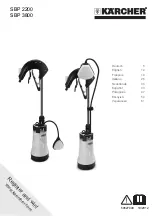
Page 7
TABLE 6
3/8" LIQUID LINE SERVICE VALVE TORQUE SPECS*
Manufacturer
Service Port
Cap Torque
Stem Cap
Torque
Seating Torque
Front Seat
PARKER
(Forged Body)
PRIMORE
(Brazed Body)
9Ć12 lbs./ft.
3Ć5 lbs./ft.
20Ć24 lbs./ft.
18Ć22 lbs./ft.
8Ć10 lbs./ft.
7Ć11 lbs./ft.
*Tighten each component firmly; if leaks are evident, tighten to
appropriate torque.
2 - Suction Line Service Valve
A full service suction line service valve is used on all HS24 seĆ
ries units. Suction valves are nonĆbackseating type. Three difĆ
ferent manufacturers of valves may be used. All suction line
service valves function the same way, differences are in
construction. Valves manufactured by Aeroquip and Parker
are forged assemblies. Valves manufactured by Primore are
brazed together. Valves are not rebuildable. Defective valves
must be replaced. The suction line service valve is illustrated
in figures 11 and 12.
SUCTION LINE SERVICE VALVE (VALVE OPEN)
FIGURE 11
SCHRADER VALVE
SERVICE PORT
SERVICE
PORT
CAP
STEM CAP
INSERT HEX WRENCH
HERE
SNAP RING
SUCTION LINE SERVICE VALVE (VALVE CLOSED)
FIGURE 12
STEM
CAP
SCHRADER VALVE
SERVICE PORT
SERVICE PORT CAP
(VALVEĆ
FRONT SEATED)
NOTE: WHEN VALVE IS FRONT SEATED THE SCHRADER
PORT IS NOT ISOLATED FROM THE SYSTEM.
SNAP RING
The valve is equipped with a service port. A schrader valve
is factory installed. A service port cap is supplied to protect
the schrader valve from contamination and assure a leak
free seal.
The suction line service valve is a front-seating valve and
does not backseat.
WARNING
Suction valves are nonĆbackseating. Do not atĆ
tempt to backseat this valve. Attempts to backseat
this valve will cause snap ring to explode from
valve body under pressure of refrigerant. PersonĆ
al injury and unit damage will result.
To Access Schrader Port:
1 - Remove service port cap with an adjustable wrench.
2 - Install in reverse order. Tighten firmly. See table 7 for
service port cap torque values.
To Open Suction Line Service Valve:
1 - Remove stem cap with an adjustable wrench.
2 - Insert a 5/16" hex wrench into the stem.
3 - Back the stem out counterclockwise until the valve
stem just touches the retaining ring.
4 - Replace stem cap, tighten firmly. See table 7 for stem
cap torque specifications.
TABLE 7
SUCTION LINE SERVICE VALVE TORQUE SPECS*
Size
Stem Cap
Torque
1/2"
6Ć10 lbs./ft.
Manufacturer Seating Torque
Front Seat
Service Port
Cap
Parker**
Aeroquip
5/8"
Parker**
3/4"
Primore
Aeroquip
7/8"
Parker**
1 1/8"
Primore
Aeroquip
Primore
18Ć20 lbs./ft.
18Ć20 lbs./ft.
18Ć20 lbs./ft.
18Ć22 lbs./ft.
22Ć25 lbs./ft.
6Ć10 lbs./ft.
6Ć10 lbs./ft.
6Ć10 lbs./ft.
6Ć10 lbs./ft.
6Ć10 lbs./ft.
6Ć10 lbs./ft.
6Ć10 lbs./ft.
12Ć16 lbs./ft.
12Ć15 lbs./ft.
15Ć20 lbs./ft.
12Ć15 lbs./ft.
12Ć16 lbs./ft.
15Ć20 lbs./ft.
15Ć20 lbs./ft.
15Ć21 lbs./ft.
**Parker valves have a forged body, Primore and Aeroquip valves have a
brazed body.
*Tighten each component firmly; if leaks are evident, tighten to
appropriate torque.
18Ć24 lbs./ft.
18Ć24 lbs./ft.
18Ć24 lbs./ft.
To Close Suction Line Service Valve:
1 - Remove stem cap with an adjustable wrench.
2 - Insert a 5/16" hex wrench into the stem.
3 - Turn stem in clockwise to seat the valve. Tighten firmly.
See table 7 for valve seating torque specifications.
4 - Replace stem cap, tighten firmly. See table 7 for stem
cap torque specifications.






























